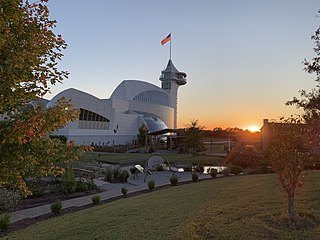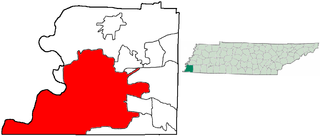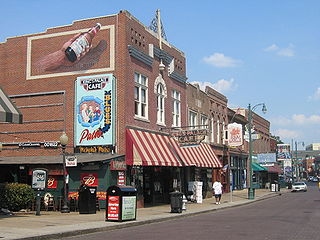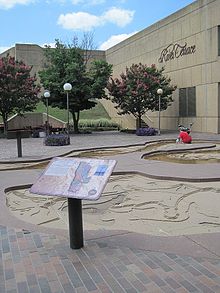
Memphis is a city along the Mississippi River in southwestern Shelby County, Tennessee, United States. Its 2019 estimated population was 651,073, making it Tennessee's second-most populous city behind Nashville, the nation's 28th-largest, and the largest city proper situated along the Mississippi River. Greater Memphis is the 42nd-largest metropolitan area in the United States, with a population of 1,348,260 in 2017. The city is the anchor of West Tennessee and the greater Mid-South region, which includes portions of neighboring Arkansas, Mississippi, and the Missouri Bootheel. Memphis is the seat of Shelby County, Tennessee's most populous county. One of the more historic and culturally significant cities of the southern United States, Memphis has a wide variety of landscapes and distinct neighborhoods.

Shelby County is located in the U.S. state of Tennessee. As of the 2010 census, the population was 927,644. It is largest of the state's 95 counties, both in terms of population and geographic area. Its county seat is Memphis, a port on the Mississippi River and the second most populous city in Tennessee. The county was named for Governor Isaac Shelby (1750–1826) of Kentucky. It is one of only two remaining counties in Tennessee, along with Haywood County, with a majority African-American population.
West Tennessee is one of the three major regions of the state of Tennessee. The region includes 21 counties west of the Tennessee River. It consists primarily of flat lands that have rich soil and vast floodplain areas for the Mississippi River.

Wolf River is a 105-mile-long (169 km) alluvial river in western Tennessee and northern Mississippi, whose confluence with the Mississippi River was the site of various Chickasaw, French, Spanish and American communities that eventually became Memphis, Tennessee. It is estimated to be about 12,000 years old, formed by Midwestern glacier runoff carving into the region's soft alluvial soil. It should not be confused with The Wolf River which flows primarily in Middle Tennessee and southern Kentucky. The Wolf River rises in the Holly Springs National Forest at Baker's Pond in Benton County, Mississippi, and flows northwest into Tennessee, before entering the Mississippi River north of downtown Memphis.

Downtown Memphis, Tennessee is the central business district of Memphis, Tennessee and is located along the Mississippi River between Interstate 40 to the north, Interstate 55 to the south and I-240 to the east, where it abuts Midtown Memphis.

Mud Island is a small peninsula located in Memphis, Tennessee. It is bordered by the Mississippi River to the west and Wolf River Harbor to the east. Mud Island River Park is located within Memphis city limits, 1.2 miles from the coast of downtown. Mud Island includes a museum, restaurants, an amphitheater, and a residential area. It is accessible by the Memphis Suspension Railway, by foot, kayak, paddle board, or automobile. Activities on Mud Island include concerts/performances, kayaking, paddle boarding, and biking. The park is currently controlled by the Riverfront Development Corporation. Admission to the park is free.

The Hernando de Soto Bridge is a through arch bridge carrying Interstate 40 across the Mississippi River between West Memphis, Arkansas, and Memphis, Tennessee. The architectural design is a continuous cantilevered cable-stayed steel through arch, with bedstead endposts. Memphians also call the bridge the "New Bridge", as it is newer than the Memphis & Arkansas Bridge downstream, and the "M Bridge", due to its distinctive shape. It is of similar construction to the Sherman Minton Bridge between Louisville, Kentucky, and New Albany, Indiana.

Memphis Central Station, referred to as Grand Central Station prior to 1944, is a passenger terminal in Memphis, Tennessee. Located along Main Street and G.E. Patterson Boulevard in Downtown Memphis, it currently a service stop for Amtrak's City of New Orleans route, arriving in late evening northbound and in the morning southbound. It is also served by the MATA Trolley system. The building was opened in 1914, and is located within the city's South Main Arts District. It is also an contributing property to the South Main Street Historic District of the National Register of Historic Places, as are the National Civil Rights Museum and other historic properties within the district boundaries.

Reverie is an unincorporated community in Tipton County, Tennessee, United States. In 2001, the population was 11.

Tom Lee Park is a city park located to the immediate west of downtown Memphis, Tennessee, overlooking the Mississippi River. Encompassing about 30 acres (12 ha) parallel to the Mississippi River for about one mile (1.6 km), it offers panoramic views of the Mississippi River and the shores of Arkansas on the opposite side. The park is named after Tom Lee, an African-American riverworker, who saved the lives of 32 passengers of the sinking steamboat M.E. Norman in 1925.

Discovery Park of America is a museum and heritage park located in Union City, Tennessee. The park sits on 50 acres (20 ha) of land off of Everett Boulevard, near the proposed Interstate 69. It features exhibits and activities on local history, nature, military history, art and science.

The City of Memphis is located on the eastern bank of the Mississippi River in the southwest corner of the U.S. state of Tennessee. It is the regional hub for a tri-state area of Arkansas, Mississippi and Tennessee.

The history of Memphis, Tennessee and its area began many thousands of years ago with succeeding cultures of indigenous peoples. In the first millennium, it was settled by the Mississippian Culture. The Chickasaw Indian tribe emerged about the 17th century, or migrated into the area. The earliest European exploration may have encountered remnants of the Mississippian culture by Spanish explorer Hernando de Soto. Later French explorers led by René-Robert Cavelier, Sieur de La Salle likely encountered the Chickasaw. The European-American city of Memphis was not founded until 1819. The city was named after the ancient capital of Egypt on the Nile River in North Africa. It rapidly developed as a major trading center for cotton cultivated at the region's large plantations and dependent on the work of enslaved African Americans. In the 19th century, and especially 1878 and 1879, the city suffered severe yellow fever epidemics. In 1878 tens of thousands of residents fled and more than 5,000 died, with hundreds more dying in the next year's epidemic, causing the city to go bankrupt and give up its charter until 1893.

Tourism in Memphis includes the points of interest in Memphis, Tennessee such as museums, fine art galleries, and parks, as well as Graceland the Beale Street entertainment district, and sporting events.

Randolph is a rural unincorporated community in Tipton County, Tennessee, United States, located on the banks of the Mississippi River. Randolph was founded in the 1820s and in 1827, the Randolph post office was established. In the 1830s, the town became an early center of river commerce in West Tennessee. Randolph shipped more cotton annually than Memphis until 1840. In 1834, the first pastor of the Methodist congregation was appointed. The fortunes of the community began to decline in the late 1840s due to failed railroad development, an unfavorable mail route and other factors. The first Confederate States Army fort in Tennessee was built at Randolph early in the Civil War in 1861, a second fortification at Randolph was constructed later that same year. During the Civil War, the town was burned down twice by Union Army forces.

The Nicholas Gotten House is located on 2969 Court Street in Bartlett, Tennessee, United States. It houses the Bartlett Museum, a local history museum operated by the Bartlett Historical Society.

Randolph is an unincorporated rural community in Tipton County, Tennessee, United States, located on the banks of the Mississippi River. The lands of the Mississippi River Basin were inhabited by Paleo-Indians and later Native American tribes of the Mississippian culture for thousands of years. The Tipton Phase people and the Chickasaw Indian tribe populated the Mississippi River valley near Randolph during the Mississippian period. In 1541, Spanish explorer Hernando de Soto crossed the Mississippi River at or near Randolph. French explorer Cavelier de La Salle built the first French fortification at or near Randolph on his 1682 canoe expedition of the Mississippi River.
Sidney L. Shlenker was an American businessman. His management/ownership of a series of professional sports teams was marked by both success and controversy.
The West Tennessee Historical Society (WTHS) is a nonprofit historical society servicing the twenty-one counties that comprise West Tennessee.
The Memphis River Parks Partnership (MRPP), known as the Riverfront Development Corporation (RDC) until being renamed in April 2018, is a nonprofit organization that manages and develops the various riverfront parks and amenities located along the Mississippi River in Memphis, Tennessee on behalf of the city government.


















